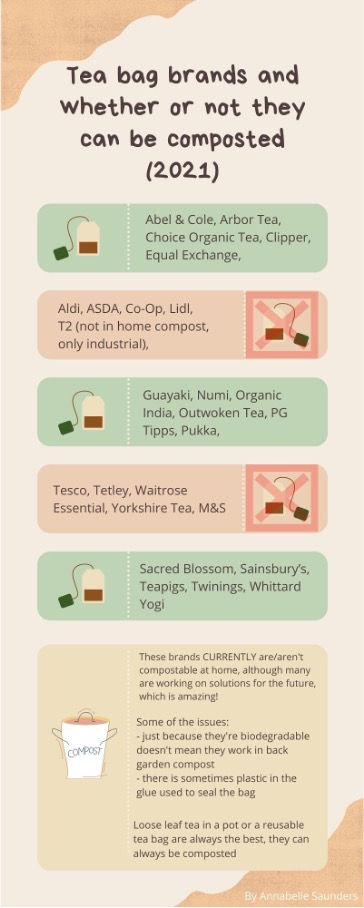It is a truth universally acknowledged that composting is good and not composting is bad. Logic would suggest that tea, a dried plant, would be fine to go straight in the compost bin and begin its beautiful journey of reincarnation, but in reality, it isn’t quite that simple.
The first thing to understand is what makes a tea bag compostable or not. A compostable tea bag needs to be made of paper, silk or muslin and sealed with a plant-based glue-like polylactic acid, a sealant made from corn starch. If a tea bag is non-compostable, it is usually because it is sealed with a plastic-based glue, or the bag itself is made of nylon, like a lot of pyramid tea bags. Yuck.
The next thing to pay attention to is the difference between biodegradable, compostable, and industrially compostable. All of these are good for the environment in the long run, but not all of them can be efficiently broken down in your home compost.
Biodegradable means that the materials used can eventually break down into particles that can integrate in a non-harmful way back into nature.
Industrially (or commercially) compostable tea bags are only reduced to tiny natural particles when they are heated to high temperatures, often over 100 degrees, and the oxygen and humidity levels are controlled.
Home composting, the kind with which we are perhaps most familiar, is for uncooked fruit and veg, paper, cardboard, tea and coffee. Home compostable tea bags are fully decomposed by worms and bacteria into nutrient-rich compost within 6 months.
So, back to the problem at hand: how to make home-compostable tea. Using any of the brands in the green boxes on the infographic are home-compost friendly. But the best way to make tea and avoid any doubt about its compostability is to use loose-leaf tea. This can be made in a teapot, but when making a single cup for yourself at university it can be a bit of a faff, and comes with the problem of the teapot-shaking dance, as you try to get the wet leaves to stop sticking to the side of the pot and fall into your compost bin. My personal favourite solutions for loose leaf tea can be found in Whittard – there is conveniently a branch in Market Square.
The first of these is the much-loved hand-held infuser. Pros: it’s quick and easy to use, Cons: some users found that small bits of leaf could come out if the two halves stopped closing properly.
This mug infuser had a higher rating of satisfaction, is very easy to use, and seemingly also easier to clean. Perfect for most loose-leaf tea with whole leaves, but still a little tricky for brands like loose-leaf Yorkshire Tea whose finer tea occasionally leaves a little powder.
The reviews for the “Fill-Me-Up” home-compostable teabags are glowing! They appear to overcome the powder and leaf-leaking which can occasionally happen with the other two and don’t require any washing up. If your favourite brand doesn’t have home-compostable tea bags, it could be worth seeing if they offer loose-leaf tea and using these handy tea bags to take matters into your own hands.
Of course, the final option is the trusty teapot and strainer. Although these can be a bit of a washing-up faff for one person, they’re the cheapest and best way to make loose-leaf tea that can be reliably composted.
A lot of brands have released statements saying that they’re working on home-compostable tea bags, so keep an eye on updates from your favourite brand if they don’t appear on the list yet! The more noise we make about wanted compostable tea bags, the more brands will rise to the occasion, so we can enjoy our five-a-day tea habits guilt and hassle-free.
—
Featured image: Jack Langton on Flickr with license.
Infographic: Annabelle Saunders

